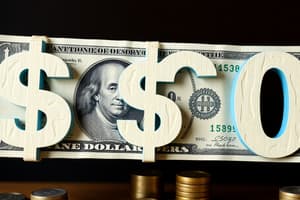Podcast
Questions and Answers
What is one of the three sources to finance a deficit according to the classical equilibrium model?
What is one of the three sources to finance a deficit according to the classical equilibrium model?
- Increasing tariffs
- Cutting public services
- Government borrowing (correct)
- Reducing consumer confidence
If government cuts taxes and consumers believe that spending will decrease in the near future, consumption will fall less.
If government cuts taxes and consumers believe that spending will decrease in the near future, consumption will fall less.
True (A)
What does the classical equilibrium model assume about the relationship between savings (S) and investment (I) when government debt increases?
What does the classical equilibrium model assume about the relationship between savings (S) and investment (I) when government debt increases?
S = I
When taxes are cut permanently, consumers will anticipate _____ in the future to pay off new debt.
When taxes are cut permanently, consumers will anticipate _____ in the future to pay off new debt.
Match the following concepts with their definitions:
Match the following concepts with their definitions:
What happens to private investment when government deficits increase?
What happens to private investment when government deficits increase?
The level of output and employment does depend on the quantity of money.
The level of output and employment does depend on the quantity of money.
What effect does tax policy have on demand and supply in relation to the price level?
What effect does tax policy have on demand and supply in relation to the price level?
Money creation affects the price level such that P changes in the same proportion as _____.
Money creation affects the price level such that P changes in the same proportion as _____.
Match the economic concepts with their effects on the price level:
Match the economic concepts with their effects on the price level:
What drives the economy according to Gross Domestic Product (GDP)?
What drives the economy according to Gross Domestic Product (GDP)?
The quantity theory of money is not related to the Classical Aggregate Demand Curve.
The quantity theory of money is not related to the Classical Aggregate Demand Curve.
What is the equilibrium interest rate?
What is the equilibrium interest rate?
According to the Classical Theory, when the interest rate falls, investment quantity _____ due to the lower cost of borrowing.
According to the Classical Theory, when the interest rate falls, investment quantity _____ due to the lower cost of borrowing.
Match the following concepts with their correct description:
Match the following concepts with their correct description:
What does labor demand depend on according to the model?
What does labor demand depend on according to the model?
Which of the following best describes the relationship between interest rates and investment?
Which of the following best describes the relationship between interest rates and investment?
The value of α is set to 1 in the assumed parameters of the model.
The value of α is set to 1 in the assumed parameters of the model.
In Classical macroeconomics, full employment exists because the Aggregate Supply curve is vertical.
In Classical macroeconomics, full employment exists because the Aggregate Supply curve is vertical.
Name one factor that can shift the demand for loans.
Name one factor that can shift the demand for loans.
What does the variable 'd' represent in the assumptions of the model?
What does the variable 'd' represent in the assumptions of the model?
The equilibrium condition of the labor market is given by __________.
The equilibrium condition of the labor market is given by __________.
Match the following parameters with their values:
Match the following parameters with their values:
What does 'M' represent in the equation of exchange?
What does 'M' represent in the equation of exchange?
In the Cambridge approach, money demand is equal to the money supply.
In the Cambridge approach, money demand is equal to the money supply.
What is the relationship between money velocity and money demand?
What is the relationship between money velocity and money demand?
In the Quantity Theory of Money, if money supply (M) is exogenous and money demand is ___, then the price level (P) depends on money supply.
In the Quantity Theory of Money, if money supply (M) is exogenous and money demand is ___, then the price level (P) depends on money supply.
Which statement accurately describes the Quantity Theory of Money?
Which statement accurately describes the Quantity Theory of Money?
The equation of exchange focuses on the money supply and all transactions in the economy.
The equation of exchange focuses on the money supply and all transactions in the economy.
What is the result when money supply equals money demand?
What is the result when money supply equals money demand?
The price level in the context of the Quantity Theory of Money is denoted as ___.
The price level in the context of the Quantity Theory of Money is denoted as ___.
What does the Cambridge approach primarily focus on?
What does the Cambridge approach primarily focus on?
Flashcards
Gross Domestic Expenditures
Gross Domestic Expenditures
A measure of all spending in an economy, focusing on consumption as the driving force.
Gross Output
Gross Output
A measure of all economic transactions, focusing on investment as the driving force.
Classical Aggregate Demand (AD)
Classical Aggregate Demand (AD)
The quantity theory of money models aggregate demand; AD = MV.
Equilibrium Interest Rate
Equilibrium Interest Rate
Signup and view all the flashcards
Investment (in classical theory)
Investment (in classical theory)
Signup and view all the flashcards
Credit/Loan Market (demand)
Credit/Loan Market (demand)
Signup and view all the flashcards
Credit/Loan Market (supply)
Credit/Loan Market (supply)
Signup and view all the flashcards
Full Employment (Classical view)
Full Employment (Classical view)
Signup and view all the flashcards
Quantity Theory of Money
Quantity Theory of Money
Signup and view all the flashcards
Equation of Exchange
Equation of Exchange
Signup and view all the flashcards
Income Velocity of Money
Income Velocity of Money
Signup and view all the flashcards
Money Demand
Money Demand
Signup and view all the flashcards
Cambridge Approach
Cambridge Approach
Signup and view all the flashcards
Money Velocity
Money Velocity
Signup and view all the flashcards
Price Level
Price Level
Signup and view all the flashcards
Real output (Y)
Real output (Y)
Signup and view all the flashcards
Constant Velocity
Constant Velocity
Signup and view all the flashcards
Monetary Equilibrium
Monetary Equilibrium
Signup and view all the flashcards
Ricardian equivalence
Ricardian equivalence
Signup and view all the flashcards
Fiscal policy impact on AD
Fiscal policy impact on AD
Signup and view all the flashcards
Government financing options
Government financing options
Signup and view all the flashcards
Debt increase and output
Debt increase and output
Signup and view all the flashcards
Permanent tax cut impact
Permanent tax cut impact
Signup and view all the flashcards
Labor demand function
Labor demand function
Signup and view all the flashcards
Labor market equilibrium condition
Labor market equilibrium condition
Signup and view all the flashcards
Model function calculations
Model function calculations
Signup and view all the flashcards
Model parameter values
Model parameter values
Signup and view all the flashcards
Model shock analysis
Model shock analysis
Signup and view all the flashcards
Crowding out effect
Crowding out effect
Signup and view all the flashcards
Money neutrality
Money neutrality
Signup and view all the flashcards
Tax policy effect on price level
Tax policy effect on price level
Signup and view all the flashcards
Money creation & Price level
Money creation & Price level
Signup and view all the flashcards
Monetary Policy's effect on nominal income
Monetary Policy's effect on nominal income
Signup and view all the flashcards
Study Notes
Quantity Theory of Money
- The price level is related to output and money quantity.
- The equation of exchange models money supply and transactions.
- Focuses on money supply, all transactions, and other factors.
- M: quantity of money.
- V: velocity of money.
- P: price index for final goods.
- Y: real output.
- MV = PY
- Income velocity of money (purchase of currently produced final goods).
- PY = Nominal GDP.
- If MV = PQ, then the price vector of all goods is considered.
- Cambridge approach emphasizes money demand.
- Md = k(PY), where Md is money demand, and k is the proportion of nominal income demanded as cash holding.
Classical Theory of Interest Rate
- Equilibrium interest rate is where lending and borrowing desires equal.
- Interest rate is the cost of borrowing.
- Investment is linked to expected profits and interest rates.
- Credit market, demand (firms & government), and supply (savers), relate inversely with interest rates.
- Investment is inversely related to interest rates.
- Savings and Investment = (G-T) + I.
- Two reasons for full employment in classical macroeconomics are supply is vertical and the interest rate relates.
Policy Implications of Classical Equilibrium Model
- Fiscal policy (changes in G) assumes a balanced budget.
- Funding deficits can stem from: taxes, debt, or money creation.
- Ricardian equivalence assumes consumers understand future tax implications, causing reduced today's consumption.
- Debt increases impact consumption and investment, but not the level of GDP.
- Crowding out effect is when private sector resources are reduced due to deficit spending.
- Fiscal policy effects do not affect price levels.
- Monetary policy (changes in M) affects price levels.
- Money neutrality: equilibrium real values aren't dependent on money quantity.
Model Example
- Macroeconomic models are available in Blackboard's spreadsheet.
- Model functions include: Y = A(K^α)(N^1-α).
- Labor demand depends on profit maximization.
- Real wage = marginal product of labor.
- Labor market equilibrium conditions are NS = ND.
- Parameter values are provided.
Studying That Suits You
Use AI to generate personalized quizzes and flashcards to suit your learning preferences.




